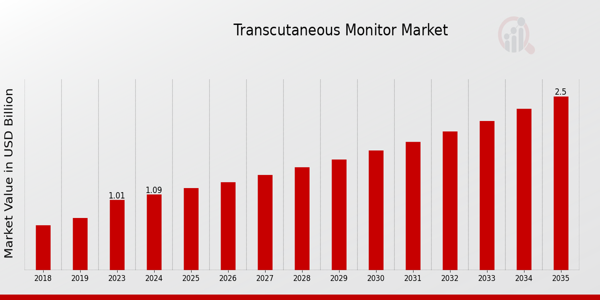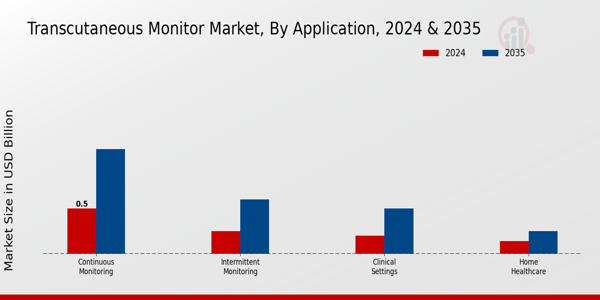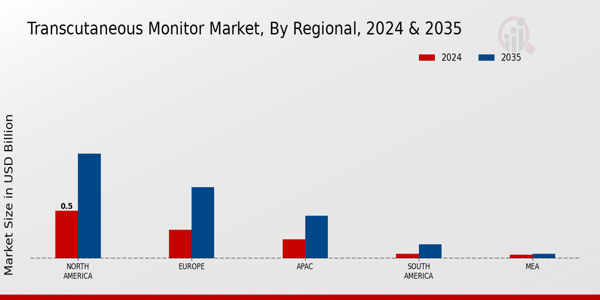Transcutaneous Monitor Market Overview
The Transcutaneous Monitor Market Size was estimated at 1.01 (USD Billion) in 2023. The Transcutaneous Monitor Market Industry is expected to grow from 1.09(USD Billion) in 2024 to 2.5 (USD Billion) by 2035. The Transcutaneous Monitor Market CAGR (growth rate) is expected to be around 7.82% during the forecast period (2025 - 2035).
Key Transcutaneous Monitor Market Trends Highlighted
The Global Transcutaneous Monitor Market is expanding swiftly owing to the rising global incidence of health issues that necessitate regular check-ups. The development of new technologies has made monitoring easier, causing more service providers to use these transcutaneous devices. Moreover, the increasing focus on home healthcare and patient-centric care is also contributing to the growth for the transcutaneous devices market. This demand enables more remote monitoring of patients which helps gain better availability for care, particularly for patients who cannot visit health institutions more often. With these monitors being part of mobile health applications, the patients become more involved in the management of their health issues, hence making the processes more effective.
There are notable opportunities to be explored within the market, particularly in the expanding geriatric population and the growing emphasis on preventive healthcare. Companies can leverage innovation in wireless technology and minimal invasive techniques to create more user-friendly devices. Furthermore, untapped markets in emerging economies present prospects for increased market penetration as healthcare infrastructure continues to improve. Collaboration between technology companies and healthcare providers can lead to the development of next generation monitoring solutions tailored to meet diverse patient needs. Recently, there has been a trend towards developing portable and wearable transcutaneous monitors, providing convenience and encouraging adherence to monitoring protocols.
The growing focus on integrating artificial intelligence and machine learning into monitoring devices is set to enhance accuracy and predictive capabilities. Environmental sustainability is also becoming a consideration in design and production, prompting companies to explore eco-friendly materials and processes. Such trends indicate a shift towards creating more advanced, user-centric solutions that align with the evolving needs of patients and healthcare systems while enriching the overall patient experience.

Source: Primary Research, Secondary Research, MRFR Database and Analyst Review
Transcutaneous Monitor Market Drivers
Technological Advancements in Monitoring Devices
The Global Transcutaneous Monitor Market Industry is witnessing remarkable growth due to emerging changes in technology about monitoring devices. New sensor technologies and a higher degree of miniaturization of electronics have yielded transcutaneous monitors that are considerably more accurate, reliable, and easier to use. These improvements help medical personnel to monitor patients more efficiently and carry out medical assistance which can greatly improve patient’s outcome at a faster rate.
In addition, the adoption of wireless communication technologies makes it possible to capture patient information and analyze it in real-time, with unprecedented ease. These devices are powered by more advanced software platforms that also improve analytics and data visualization, helping the clinicians make decisions faster than before. The growing trend in monitoring devices has been wished for by the hospitals and care centers because it helps them improve their patient care standards and their operational service efficiency at the same time.
This trend is expected to positively affect the Global Transcutaneous Monitor Market in the next few years, and as a result, aid in fuelling innovation and investment in the healthcare sector. The trend is abandoning old devices in favour of newer tech with higher demands in these new-age devices which ensure better research and development schemes, resulting in the device being more popular amongst consumers, leading to growth in the market.
Rising Prevalence of Chronic Diseases
An increase in the prevalence of chronic diseases such as diabetes, cardiovascular conditions, and respiratory illnesses is a significant driver of the Global Transcutaneous Monitor Market Industry. These conditions often require continuous monitoring of vital signs and blood parameters to ensure effective management and treatment. Consequently, there is a growing demand for transcutaneous monitors that provide real-time insights into patients' health status.As healthcare providers increasingly recognize the importance of early diagnosis and continuous monitoring in managing chronic diseases, the market for transcutaneous monitoring solutions continues to expand. This trend is anticipated to be a key factor propelling the market's growth over the coming years.
Increasing Adoption of Home Healthcare Solutions
The trend toward home healthcare solutions is significantly influencing the growth of the Global Transcutaneous Monitor Market Industry. As patients seek more convenient and cost-effective care options, the demand for portable and user-friendly monitoring devices has surged. Home healthcare empowers patients to manage their health more independently while ensuring that healthcare professionals can maintain oversight remotely. This shift has increased the need for reliable transcutaneous monitors that offer accurate readings and usability in non-clinical environments.As the healthcare landscape continues to evolve, the focus on home-based care is expected to further enhance market growth.
Transcutaneous Monitor Market Segment Insights
Transcutaneous Monitor Market Application Insights
The Application segment of the Global Transcutaneous Monitor Market plays a crucial role in shaping the revenue landscape, reflecting the increasing demand for efficient monitoring solutions in healthcare. As of 2024, the market for Continuous Monitoring holds significant value at 0.5 USD Billion and is expected to grow to 1.15 USD Billion by 2035, showcasing its major foothold in industry. Continuous Monitoring offers real-time data, which is essential for critical care settings; thus, it not only dominates the Application segment but also represents a preferred choice due to its ability to provide timely interventions. Intermittent Monitoring, valued at 0.25 USD Billion in 2024 and projected to increase to 0.6 USD Billion by 2035, serves an important niche, catering to patients who do not require constant supervision.
This approach balances the need for monitoring with patient comfort, making it a favorable option in outpatient scenarios. The Clinical Settings segment, valued at 0.2 USD Billion in 2024 with an expected growth to 0.5 USD Billion by 2035, underlines the reliance on transcutaneous monitoring equipment within hospitals and clinics. The increase reflects the sector's ongoing commitment to enhancing patient care, although it holds a smaller share compared to Continuous Monitoring due to the high dependency on immediate monitoring for critical cases.Home Healthcare appears as an emerging field with a modest valuation of 0.14 USD Billion in 2024, increasing to 0.25 USD Billion by 2035.
As more patients transition to receiving care at home, the significance of monitoring solutions designed for home use continues to rise. This segment's growth highlights the evolving dynamics of healthcare delivery, where convenience and accessibility are paramount. Overall, the Global Transcutaneous Monitor Market segmentation demonstrates distinct growth trajectories for each application area, driven by technological advancements and increasing healthcare requirements. These data points and market statistics reflect key trends and opportunities within the industry, as healthcare providers respond to the growing demand for both continuous and intermittent monitoring solutions across various environments.

Source: Primary Research, Secondary Research, MRFR Database and Analyst Review
Transcutaneous Monitor Market End Use Insights
The Global Transcutaneous Monitor Market revenue is significantly influenced by its End Use segmentation, which includes Hospitals, Ambulatory Surgical Centers, Homecare Settings, and Diagnostic Centers. The market in 2024 is expected to reach a value of 1.09 billion USD, reflecting the growing necessity for non-invasive monitoring solutions. Hospitals play a crucial role in the market, as they are the primary users of transcutaneous monitors for patient management and critical care. Ambulatory Surgical Centers are also becoming increasingly important due to the rising trend towards outpatient procedures, making monitoring more essential during surgeries.Homecare Settings have gained traction as healthcare systems shift towards more at-home patient care, offering convenience and efficiency, while Diagnostic Centers support the demand for accurate and timely patient assessments.
The overall Global Transcutaneous Monitor Market data showcases robust growth driven by technological advancements, increasing prevalence of chronic diseases, and a rising geriatric population. However, the market faces challenges including regulatory barriers and the need for operator training. Nevertheless, opportunities exist for enhancing product offerings and expanding into emerging markets, which creates a favorable environment for sustained market growth..
Transcutaneous Monitor Market Product Type Insights
The Global Transcutaneous Monitor Market revenue is evolving significantly, with the market expected to reach a value of 1.09 billion USD by 2024. Within this landscape, the market segmentation for Product Type plays a vital role in understanding various dynamics, including Handheld Monitors, Portable Monitors, and Stationary Monitors. Handheld Monitors have gained traction due to their ease of use and mobility, catering to both clinical and home settings. Portable Monitors also contribute substantially, appealing to users who require flexibility and convenience without compromising on monitoring capabilities.
Stationary Monitors dominate in hospital environments where continuous patient monitoring is critical, allowing for detailed and real-time data acquisition. The diversity among these product types indicates broader market opportunities, driven by technological advancements and increasing healthcare demands. Market growth is largely supported by the rising prevalence of chronic diseases, increasing geriatric population, and a strong focus on home healthcare solutions. However, challenges such as regulatory hurdles and variations in product preferences across regions may impact market expansion.The Global Transcutaneous Monitor Market statistics suggest a clear emphasis on enhancing patient comfort and monitoring accuracy, which is crucial for the industry's future.
Transcutaneous Monitor Market Measurement Type Insights
The Global Transcutaneous Monitor Market revenue is projected to reach $1.09 billion in 2024, reflecting a growing focus on non-invasive monitoring technologies across various healthcare settings. Within the measurement type, Oxygen Saturation Monitoring plays a crucial role, as it caters to patients with respiratory issues, while Carbon Dioxide Monitoring is essential for assessing ventilation and patient safety during procedures. pH Monitoring is also significant, especially in critical care units, as it aids in evaluating the metabolic state and ensuring proper acid-base balance.Metabolic Monitoring is gaining traction as it supports real-time metabolic assessments, enhancing patient management and treatment plans.
This segment's growth is fueled by increasing awareness of patient safety, a rise in respiratory conditions, and the need for real-time monitoring solutions while challenges such as calibration requirements and technology costs persist. The Global Transcutaneous Monitor Market segmentation highlights the importance of each monitoring type in delivering improved patient outcomes and effective healthcare solutions.Market growth is further supported by advances in sensor technologies and the integration of these devices into telehealth applications, opening new opportunities for expansion.
Transcutaneous Monitor Market Regional Insights
The Global Transcutaneous Monitor Market revenue is experiencing significant growth across various regions, with North America holding a substantial portion of the market. Valued at 0.5 USD Billion in 2024 and expected to rise to 1.1 USD Billion by 2035, North America is a major player due to advanced healthcare infrastructure and technology adoption. Europe follows, with a valuation of 0.3 USD Billion in 2024, expected to increase to 0.75 USD Billion by 2035, showcasing steady demand amid growing chronic diseases. The APAC region, while smaller, generates significant opportunity, valued at 0.2 USD Billion in 2024 and projected to reach 0.45 USD Billion by 2035, driven by increasing healthcare investments.
Meanwhile, South America and MEA represent the least dominant markets, with valuations of 0.05 and 0.04 USD Billion in 2024, respectively. However, they exhibit potential for growth as healthcare accessibility improves and awareness of transcutaneous monitoring benefits expands. The Global Transcutaneous Monitor Market statistics reveal that regional dynamics and healthcare policies play a crucial role in shaping market trends, opportunities, and overall market growth for transcutaneous monitoring technologies.

Source: Primary Research, Secondary Research, MRFR Database and Analyst Review
Transcutaneous Monitor Market Key Players and Competitive Insights
The Global Transcutaneous Monitor Market is witnessing significant competitive dynamics driven by advancements in healthcare technology and increasing demand for non-invasive monitoring solutions. As healthcare providers increasingly emphasize patient comfort, the role of transcutaneous monitors in assessing various physiological parameters is gaining traction. Key players in this market are focusing on enhancing their product offerings through innovations in sensor technology, connectivity, and data analytics. The competitive landscape is characterized by diverse strategies, including mergers and acquisitions, collaborations, and the introduction of advanced products tailored to meet the evolving needs of healthcare professionals. Companies are also investing in research and development to provide more precise and reliable monitoring solutions, ultimately improving patient outcomes, and optimizing clinical workflows.
Abbott Laboratories has established a strong presence in the Global Transcutaneous Monitor Market, leveraging its extensive portfolio of medical devices and strong commitment to innovation. The company is known for its rigorous research and development efforts, driving advancements in transcutaneous monitoring technology that enhance usability and accuracy. Abbott Laboratories focuses on creating integrated health solutions that streamline patient monitoring and provide healthcare professionals with real-time data. Its established relationships with healthcare providers and ongoing commitment to improving patient care position Abbott favorably in the competitive landscape. The strength of Abbott Laboratories lies in its ability to merge high-quality product design with robust clinical evidence, which continually reinforces customer trust and loyalty, making it a key player in the transcutaneous monitoring sector.
Philips Healthcare also plays a significant role in the Global Transcutaneous Monitor Market, driven by its innovative approach to healthcare technology. The company emphasizes providing comprehensive monitoring solutions that are not only accurate but also user-friendly, which is essential for effective patient management. Philips Healthcare is renowned for its advanced monitoring systems that integrate seamlessly into hospital workflows, enabling real-time patient assessments and enhancing clinical decision-making. The firm's strong emphasis on patient-centric technologies and its drive to provide solutions that address specific clinical needs further contribute to its competitive edge. Philips Healthcare continues to invest in digital health and data integration, solidifying its reputation as a leader in the transcutaneous monitoring market, with an unwavering focus on improving healthcare outcomes through cutting-edge technological advancements.
Key Companies in the Transcutaneous Monitor Market Include
- Abbott Laboratories
- Philips Healthcare
- GE Healthcare
- Wireless Medical Technologies
- Nihon Kohden
- Masimo
- Drägerwerk
- Opto Circuits
- Sensible Medical Innovations
- Nonin Medical
- Honeywell
- MediGadget
- Smiths Medical
- Medtronic
- Edan Instruments
Transcutaneous Monitor Market Industry Developments
The Global Transcutaneous Monitor Market has recently seen significant developments, particularly with technological advancements in non-invasive transcutaneous monitoring systems. Companies such as Abbott Laboratories and Masimo are innovating with algorithms that enhance the accuracy of vital sign measurements, stimulating interest among healthcare providers. Philips Healthcare and GE Healthcare are also making strides in integrating their monitors with advanced telemedicine features, aligning with the growing trend towards remote patient monitoring.
In terms of mergers and acquisitions, reports indicate that Honeywell is exploring potential partnerships to strengthen its presence in the telehealth domain, while Wireless Medical Technologies has made strategic collaborations to enhance its product offerings. The market is experiencing growth, fueled by increasing demand for continuous monitoring solutions in critical care, which is positively impacting the valuations of key players like Drägerwerk and Sensible Medical Innovations. Furthermore, the rise in regulatory support for remote monitoring solutions is likely to create new opportunities for companies such as Edan Instruments and Nonin Medical, solidifying their market positions. Overall, these developments reflect a significant transformation in the Transcutaneous Monitor Market landscape, driven by innovation and strategic alliances among major industry players.
Transcutaneous Monitor Market Segmentation Insights
Transcutaneous Monitor Market Application Outlook
- Continuous Monitoring
- Intermittent Monitoring
- Clinical Settings
- Home Healthcare
Transcutaneous Monitor MarketEnd Use Outlook
- Hospitals
- Ambulatory Surgical Centers
- Homecare Settings
- Diagnostic Centers
Transcutaneous Monitor Market Product Type Outlook
- Handheld Monitors
- Portable Monitors
- Stationary Monitors
Transcutaneous Monitor Market Measurement Type Outlook
- Oxygen Saturation Monitoring
- Carbon Dioxide Monitoring
- pH Monitoring
- Metabolic Monitoring
Transcutaneous Monitor Market Regional Outlook
- North America
- Europe
- South America
- Asia Pacific
- Middle East and Africa
| Attribute/Metric Source: |
Details |
| MARKET SIZE 2023 |
1.01(USD Billion) |
| MARKET SIZE 2024 |
1.09(USD Billion) |
| MARKET SIZE 2035 |
2.5(USD Billion) |
| COMPOUND ANNUAL GROWTH RATE (CAGR) |
7.82% (2025 - 2035) |
| REPORT COVERAGE |
Revenue Forecast, Competitive Landscape, Growth Factors, and Trends |
| BASE YEAR |
2024 |
| MARKET FORECAST PERIOD |
2025 - 2035 |
| HISTORICAL DATA |
2019 - 2024 |
| MARKET FORECAST UNITS |
USD Billion |
| KEY COMPANIES PROFILED |
Abbott Laboratories, Philips Healthcare, GE Healthcare, Wireless Medical Technologies, Nihon Kohden, Masimo, Drägerwerk, Opto Circuits, Sensible Medical Innovations, Nonin Medical, Honeywell, MediGadget, Smiths Medical, Medtronic, Edan Instruments |
| SEGMENTS COVERED |
Application, End Use, Product Type, Measurement Type, Regional |
| KEY MARKET OPPORTUNITIES |
Rising demand for non-invasive monitoring, Increasing prevalence of chronic diseases, Technological advancements in sensor design, Expanding healthcare infrastructure in emerging markets, Growing geriatric population driving demand |
| KEY MARKET DYNAMICS |
Increasing prevalence of chronic diseases, Technological advancements in monitoring devices, Rising demand for non-invasive procedures, Growing geriatric population, Expanding home healthcare market |
| COUNTRIES COVERED |
North America, Europe, APAC, South America, MEA |
Frequently Asked Questions (FAQ) :
The Global Transcutaneous Monitor Market is expected to be valued at 1.09 billion USD in 2024.
By 2035, the Global Transcutaneous Monitor Market is projected to reach a value of 2.5 billion USD.
The expected CAGR for the Global Transcutaneous Monitor Market from 2025 to 2035 is 7.82%.
North America is anticipated to have the largest market share, valued at 0.5 billion USD in 2024.
The market value for Continuous Monitoring is expected to be 1.15 billion USD in 2035.
Major players include Abbott Laboratories, Philips Healthcare, GE Healthcare, and Masimo among others.
The market value for the Intermittent Monitoring application is projected to be 0.25 billion USD in 2024.
The market for Home Healthcare is expected to grow to 0.25 billion USD by 2035.
The expected market value for Europe in 2035 is projected to be 0.75 billion USD.
The APAC region is anticipated to reach a market value of 0.45 billion USD by 2035.

















